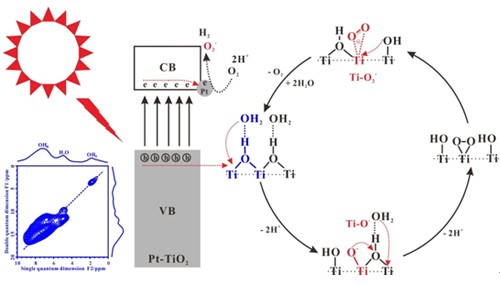Transfer Channel of Photoinduced Holes on a TiO2 Surface Revealed
Date:2017/7/19 16:42:36 Views:Times
The detailed structure–activity relationship of surface hydroxyl groups (Ti–OH) and adsorbed water (H2O) on the TiO2 surface should be the key to clarifying the photogenerated hole (h+) transfer mechanism for photocatalytic water splitting, which however is still not well understood. Herein, one- and two-dimensional 1H solid-state NMR techniques were employed to identify surface hydroxyl groups and adsorbed water molecules as well as their spatial proximity/interaction in TiO2 photocatalysts. It was found that although the two different types of Ti–OH (bridging hydroxyl (OHB) and terminal hydroxyl (OHT) groups were present on the TiO2 surface, only the former is in close spatial proximity to adsorbed H2O, forming hydrated OHB. In situ 1H and 13C NMR studies of the photocatalytic reaction on TiO2 with different Ti–OH groups and different H2O loadings illustrated that the enhanced activity was closely correlated to the amount of hydrated OHB groups. To gain insight into the role of hydrated OHB groups in the h+ transfer process, in situ ESR experiments were performed on TiO2 with variable H2O loading, which revealed that the hydrated OHB groups offer a channel for the transfer of photogenerated holes in the photocatalytic reaction, and the adsorbed H2O could have a synergistic effect with the neighboring OHB group to facilitate the formation and evolution of active paramagnetic intermediates. On the basis of experimental observations, the detailed photocatalytic mechanism of water splitting on the surface of TiO2 was proposed.

Link:https://pubs.acs.org/doi/full/10.1021/jacs.7b04877



